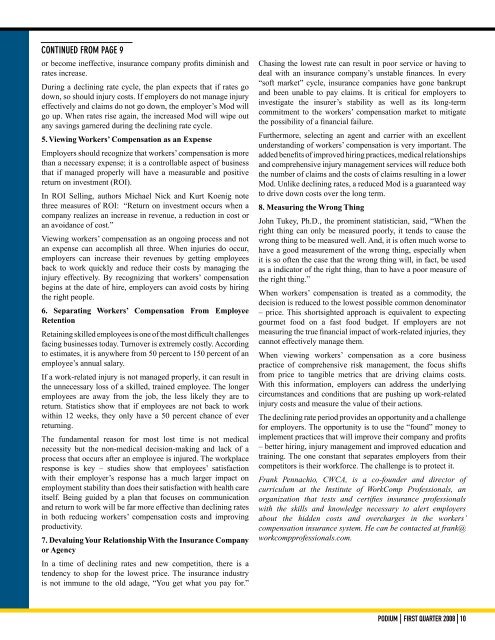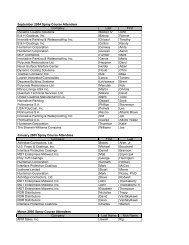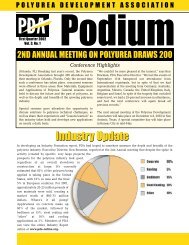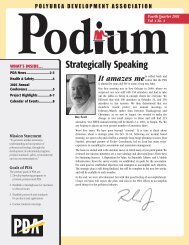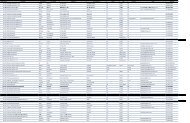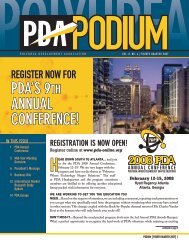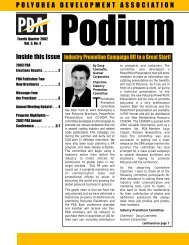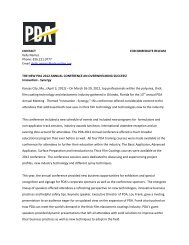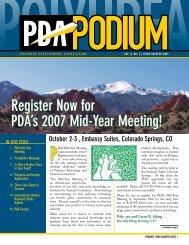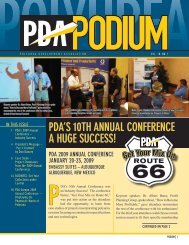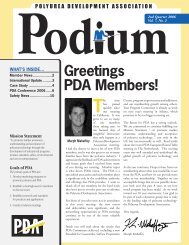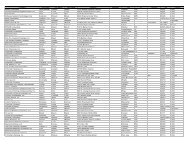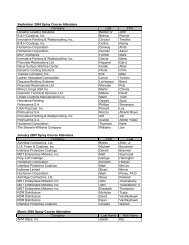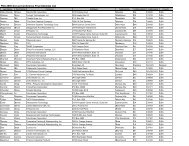PDA's 9th Annual Conference a Huge SUCCESS! - Polyurea ...
PDA's 9th Annual Conference a Huge SUCCESS! - Polyurea ...
PDA's 9th Annual Conference a Huge SUCCESS! - Polyurea ...
You also want an ePaper? Increase the reach of your titles
YUMPU automatically turns print PDFs into web optimized ePapers that Google loves.
CONTINUED FROM PAGE 9<br />
or become ineffective, insurance company profits diminish and<br />
rates increase.<br />
During a declining rate cycle, the plan expects that if rates go<br />
down, so should injury costs. If employers do not manage injury<br />
effectively and claims do not go down, the employer’s Mod will<br />
go up. When rates rise again, the increased Mod will wipe out<br />
any savings garnered during the declining rate cycle.<br />
5. Viewing Workers’ Compensation as an Expense<br />
Employers should recognize that workers’ compensation is more<br />
than a necessary expense; it is a controllable aspect of business<br />
that if managed properly will have a measurable and positive<br />
return on investment (ROI).<br />
In ROI Selling, authors Michael Nick and Kurt Koenig note<br />
three measures of ROI: “Return on investment occurs when a<br />
company realizes an increase in revenue, a reduction in cost or<br />
an avoidance of cost.”<br />
Viewing workers’ compensation as an ongoing process and not<br />
an expense can accomplish all three. When injuries do occur,<br />
employers can increase their revenues by getting employees<br />
back to work quickly and reduce their costs by managing the<br />
injury effectively. By recognizing that workers’ compensation<br />
begins at the date of hire, employers can avoid costs by hiring<br />
the right people.<br />
6. Separating Workers’ Compensation From Employee<br />
Retention<br />
Retaining skilled employees is one of the most difficult challenges<br />
facing businesses today. Turnover is extremely costly. According<br />
to estimates, it is anywhere from 50 percent to 150 percent of an<br />
employee’s annual salary.<br />
If a work-related injury is not managed properly, it can result in<br />
the unnecessary loss of a skilled, trained employee. The longer<br />
employees are away from the job, the less likely they are to<br />
return. Statistics show that if employees are not back to work<br />
within 12 weeks, they only have a 50 percent chance of ever<br />
returning.<br />
The fundamental reason for most lost time is not medical<br />
necessity but the non-medical decision-making and lack of a<br />
process that occurs after an employee is injured. The workplace<br />
response is key – studies show that employees’ satisfaction<br />
with their employer’s response has a much larger impact on<br />
employment stability than does their satisfaction with health care<br />
itself. Being guided by a plan that focuses on communication<br />
and return to work will be far more effective than declining rates<br />
in both reducing workers’ compensation costs and improving<br />
productivity.<br />
7. Devaluing Your Relationship With the Insurance Company<br />
or Agency<br />
In a time of declining rates and new competition, there is a<br />
tendency to shop for the lowest price. The insurance industry<br />
is not immune to the old adage, “You get what you pay for.”<br />
Chasing the lowest rate can result in poor service or having to<br />
deal with an insurance company’s unstable finances. In every<br />
“soft market” cycle, insurance companies have gone bankrupt<br />
and been unable to pay claims. It is critical for employers to<br />
investigate the insurer’s stability as well as its long-term<br />
commitment to the workers’ compensation market to mitigate<br />
the possibility of a financial failure.<br />
Furthermore, selecting an agent and carrier with an excellent<br />
understanding of workers’ compensation is very important. The<br />
added benefits of improved hiring practices, medical relationships<br />
and comprehensive injury management services will reduce both<br />
the number of claims and the costs of claims resulting in a lower<br />
Mod. Unlike declining rates, a reduced Mod is a guaranteed way<br />
to drive down costs over the long term.<br />
8. Measuring the Wrong Thing<br />
John Tukey, Ph.D., the prominent statistician, said, “When the<br />
right thing can only be measured poorly, it tends to cause the<br />
wrong thing to be measured well. And, it is often much worse to<br />
have a good measurement of the wrong thing, especially when<br />
it is so often the case that the wrong thing will, in fact, be used<br />
as a indicator of the right thing, than to have a poor measure of<br />
the right thing.”<br />
When workers’ compensation is treated as a commodity, the<br />
decision is reduced to the lowest possible common denominator<br />
– price. This shortsighted approach is equivalent to expecting<br />
gourmet food on a fast food budget. If employers are not<br />
measuring the true financial impact of work-related injuries, they<br />
cannot effectively manage them.<br />
When viewing workers’ compensation as a core business<br />
practice of comprehensive risk management, the focus shifts<br />
from price to tangible metrics that are driving claims costs.<br />
With this information, employers can address the underlying<br />
circumstances and conditions that are pushing up work-related<br />
injury costs and measure the value of their actions.<br />
The declining rate period provides an opportunity and a challenge<br />
for employers. The opportunity is to use the “found” money to<br />
implement practices that will improve their company and profits<br />
– better hiring, injury management and improved education and<br />
training. The one constant that separates employers from their<br />
competitors is their workforce. The challenge is to protect it.<br />
Frank Pennachio, CWCA, is a co-founder and director of<br />
curriculum at the Institute of WorkComp Professionals, an<br />
organization that tests and certifies insurance professionals<br />
with the skills and knowledge necessary to alert employers<br />
about the hidden costs and overcharges in the workers’<br />
compensation insurance system. He can be contacted at frank@<br />
workcompprofessionals.com.<br />
PODIUM | FIRST QUARTER 2008 | 10


